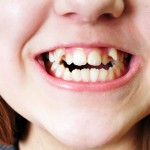
The treatment of severe crowding caused by tooth size arch length deficiency (TSALD) can be treated early with serial tooth extractions in the early mixed dentition or late with extractions of premolars. The ideal time for treatment is a matter of debate.
The aim of this review was to assess whether the occlusal and secondary outcomes of treatment with early first premolar extraction equivalent to those obtained with late treatment?
Methods
Searches were conducted in PubMed, Ovid, Scopus, Virtual Health Library, and The Cochrane Library. Randomised controlled trials (RCTs) human clinical trials with a prospective or retrospective design that evaluated treatment of patients with severe crowding caused by TSALD were considered. Two reviewers independently screened studies for inclusion and study quality was assessed using the NICE methodological checklist for prognostic studies.
Results
- 7 retrospective studies were included
- 4 showed improvement of the primary outcome (correction of severe crowding) but there were no differences between the early and late treatment.
- 3 studies evaluated the total and active duration of the treatment
- 2 studies evaluated post retention collapse.
Conclusions
The authors concluded
Both early and late extraction had a similar effect on correction of crowding. Early treatment had two favourable secondary outcomes (less relapse and reduced active treatment time) versus late treatment. However, the levels of evidence were not sufficient to assert which protocol was superior.
Commentary
While a number of databases were searched only 7 retrospective studies were identified and as noted by the review authors they had small sample sizes and a number of other potential biases. Consequently the findings should be viewed with caution. Earlier this year ( Dental Elf 14th Jan -2014) we looked at the Cochrane review (Thiruvenkatachari et al. 2014) which focused on the treatment of class II malocclusions. They identified 17 RCTs and interestingly apart for a reduction of incisal trauma in early adolescence they also found no advantage in providing early orthodontic treatment.
Links
Filho HL, Maia LH, Lau TC, de Souza MM, Maia LC. Early vs late orthodontic treatment of tooth crowding by first premolar extraction: A systematic review. Angle Orthod. 2014 Sep 10. [Epub ahead of print] PubMed PMID: 25208231.
Thiruvenkatachari B, Harrison JE, Worthington HV, O’Brien KD. Orthodontic treatment for prominent upper front teeth (Class II malocclusion) in children. Cochrane Database of Systematic Reviews 2013, Issue 11. Art. No.: CD003452. DOI: 10.1002/14651858.CD003452.pub3.
Dental Elf 7th Jan – 2014 – Early orthodontic treatment may reduce incisal trauma in children with class II malocclusions

The treatment of severe crowding can be treated early or late. The ideal time for treatment is a matter of debate http://t.co/Yw0RTASCpu
SR aimed to assess the outcomes of treatment with early first premolar extraction compared with late treatment? http://t.co/Yw0RTASCpu
4 studies showed improvement in the correction of crowding, but no differences between the early and late treatment http://t.co/Yw0RTASCpu
Don’t miss: Orthodontic treatment for crowding: review found similar results with early and late extractions http://t.co/Yw0RTASCpu
Both extractions had a similar effect on correction of crowding. Early had two favourable outcomes compared to late http://t.co/Yw0RTASCpu
[…] Dental Elf – 15th Sept 2014 – Orthodontic treatment for crowding: review found similar r… […]